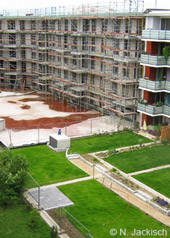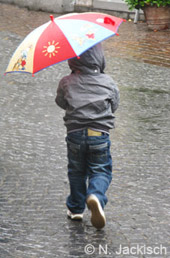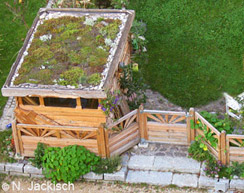
Although there are guidelines and laws on the use of plant protection products and biocides, limit values and environmental quality standards are often exceeded in ground and surface waters (Wicke et al., 2015).
In some cases, biocide loads of urban origin in water bodies can be higher than pesticide loads from agriculture (Gerecke et al., 2002 and Wittmer et al., 2011).
In order to determine the exact risks of biocides, it is necessary to know which biocides are used in the different material protection products, as each biocide has different toxicity and environmental impacts. Selected biocides commonly used in facade protection are presented below. They are representative of the general hazards posed by biocides.
In some cases, biocide loads of urban origin in water bodies can be higher than pesticide loads from agriculture (Gerecke et al., 2002 and Wittmer et al., 2011).
In order to determine the exact risks of biocides, it is necessary to know which biocides are used in the different material protection products, as each biocide has different toxicity and environmental impacts. Selected biocides commonly used in facade protection are presented below. They are representative of the general hazards posed by biocides.

- Diuron
-
Diuron is a herbicide that is more frequently used as a biocide in facade protection. Diuron is, in contrast to many other biocides, relatively well researched, because already in 1956 Wessels and Van der Veen described its effect.
Diuron is used against weeds and mosses as a biocide in material protection and as a plant protection product in agriculture. It is one of the 45 priority substances of the EU Water Framework Directive and is banned as a plant protection product in Germany. In the environment, it tends to be retained in humus-rich soils, but can also be leached and thus enter groundwater, where relatively long residence times can be expected (Lange et al., 2017; Gooddy et al., 2002; Giacomazzi and Cochet, 2004). It is mainly transformed to 3,4-dichloroanilines (3,4- DCA) by fungi or bacteria. The problem is that the transformation products are sometimes more toxic than diuron itself (Giacomazzi and Cochet, 2004). According to the European Chemicals Agency (ECHA), diuron is very toxic to aquatic life with long-lasting effects and is suspected of being carcinogenic.

- Terbutryn
-
Terbutryn is also a herbicide with a similar mode of action as diuron and comparable distribution in facade protection. Similar to diuron, it is a priority substance in the EU Water Framework Directive and banned as a plant protection product in agriculture in Germany. It is therefore only used in Germany for domestic use or protection of building materials as a biocide.
Nevertheless, as shown by Quednow and Püttmann (2007), it can be detected in surface waters (282 of 330 samples were positive), which is problematic with regard to its high toxicity to aquatic life (ECHA). Due to its frequent use in facades, terbutryn is well suited as a tracer for facade runoff (Burkhardt et al., 2011).
Literature:
- Bollmann, Ulla E.; Fernández-Calviño, David; Brandt, Kristian K.; Storgaard, Morten S.; Sanderson, Hans; Bester, Kai (2017): Biocide Runoff from Building Facades: Degradation Kinetics in Soil. In: Environmental science & technology 51 (7), pp. 3694-3702.
- Bork, Marcus; Lange, Jens; Graf-Rosenfellner, Markus; Hensen, Birte; Olsson, Oliver; Hartung, Thomas et al. (2021): Urban storm water infiltration systems are not reliable sinks for biocides: evidence from column experiments. In: Scientific reports 11 (1).
- Burkhardt, M., Zuleeg, S., Vonbank, R., Schmid, P., Hean, S., Lamani, X., Bester, K., Boller, M., 2011. Leaching of additives from construction materials to urban storm water runoff. Water Science & Technology 63.
- Gerecke, A. et al., 2002. Sources of pesticides in surface waters in Switzerland: pesticide load through waste water treatment plants - current situation and reduction potential. Chemosphere, 48.
- Giacomazzi, S., Cochet, N., 2004. environmental impact of diuron transformation: a review. Chemosphere 56.
- Gooddy, D.C., Chilton, P., Harrison, I., 2002. A field study to assess the degradation and transport of diuron and its metabolites in a calcareous soil. Science of The Total Environment 297.
- Lange, J., Olsson, O., Jackisch, N., Weber, T., Hensen, B., Zieger, F., Schuetz, T., Kümmerer, K., 2017. Urbane Regenwasserversickerung als Eintragspfad für biozide Wirkstoffe in das Grundwasser? Korrespondenz Wasserwirtschaft. (“Urban rainwater infiltration as an input pathway for biocidal active substances to groundwater?”)
- Paijens, Claudia; Bressy, Adèle; Frère, Bertrand; Moilleron, Régis (2019): Biocide emissions from building materials during wet weather. Identification of substances, mechanism of release and transfer to the aquatic environment. In: Environmental Science and Pollution Research 27 (4), pp. 3768-3791.
- Paijens, Claudia; Bressy, Adèle; Frère, Bertrand; Tedoldi, Damien; Mailler, Romain; Rocher, Vincent et al. (2021): Urban pathways of biocides towards surface waters during dry and wet weathers. Assessment at the Paris conurbation scale. In: Journal of hazardous materials 402, p. 123765.
- Quednow, K., Püttmann, W., 2007. monitoring terbutryn pollution in small rivers of hesse, germany. Journal of Environmental Monitoring 9.
- Schoknecht, Ute; Mathies, Helena (2016): Emissions of material preservatives into the environment - realistic estimation of environmental risks through the improved characterisation of the leaching of biocides from treated materials used outdoors. Ed. by Federal Environment Agency. Federal Environment Agency. Dessau-Roßlau.
- Umweltbundesamt (2017): Sind Biozideinträge in die Umwelt von besorgniserregendem Ausmaß? Empfehlungen des Umweltbundesamtes für eine Vorgehensweise zur Untersuchung der Umweltbelastung durch Biozide. Hg. v. Fachgebiet IV 1.2 Biozide, Umweltbundesamt. Umweltbundesamt. Dessau-Roßlau. (“Are biocide inputs to the environment of concern? Recommendations of the Federal Environment Agency for a procedure to investigate environmental pollution by biocides.”)
- Wicke, D., Matzinger, A. & Rouault, P., 2015. Relevance of organic trace substances in stormwater runoff of Berlin, Berlin: KompetenzZentrum Wasser Berlin GmbH.
- Wicke, Daniel; Matzinger, Andreas; Sonnenberg, Hauke; Caradot, Nicolas; Schubert, Rabea-Luisa; Dick, Robert et al. (2021): Micropollutants in Urban Stormwater Runoff of Different Land Uses. In: Water 13 (9), p. 1312.
- Wittmer, I. et al., 2011. Loss rates of urban biocides can exceed those of agricultural pesticides. Science of the Total Environment, 409.





